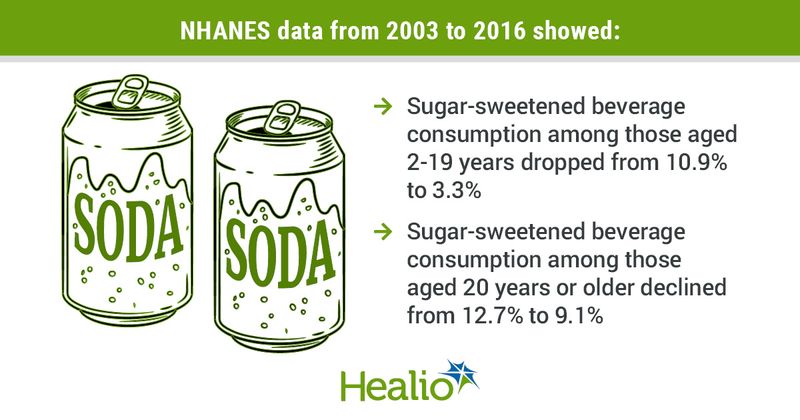Heavy consumption of sugar-sweetened beverages significantly declines in US
Click Here to Manage Email Alerts
Overall, the percentage children and adults who drank about 3.5 12-ounce cans of regular soda each day dropped in the United States during a recent 13-year period, researchers reported.
Kelsey A. Vercammen, MSc, a doctoral candidate in the department of epidemiology at the Harvard T.H. Chan School of Public Health, and colleagues analyzed data from the National Health and Nutrition Examination Survey captured between 2003 and 2016. Their analysis included 21,783 children and adolescents aged 2 to 19 years and 32,355 adults aged 20 years and older.

Heavy SSB consumption among children
The researchers found that among all children, the percentage of heavy sugar-sweetened beverage (SSB) consumers significantly declined, from 10.9% to 3.3% (P < .001). The percentage also dropped among non-Hispanic whites (12.1% to 3.7%;P < .001), non-Hispanic Blacks (10.9% to 3.3%; P < .001), Mexican-Americans (10.7% to 2.5%; P < .001) and non-Mexican Hispanics (8% to 2.8%; P = .028). Although the percentages of children of other races and ethnicities also reduced their SSB intake, the rates were not statistically significant.
There was also a significant decline in the percentage of heavy SSB consumers among children whose family income was less than 130% of the Federal Poverty Level (9.6% to 3.3%; P < .001) and more than 130% of the Federal Poverty Level (11.5% to 3.3%; P < .001). Stratified by sex, the data showed a decrease in heavy SSB consumption among girls (7.1% to 2.8%; P < .001) and boys (14.5% to 3.7%; P < .001), but boys had higher levels of heavy SSB intake across all years vs. girls. Those aged 12 to 19 years had the greatest proportion of heavy SSB consumers(11.8% to 4.9%; P = .001), researchers said.
Heavy SSB consumption among adults
Among adults in general, the researchers found that the percentage of heavy SSB consumers dropped from 12.7% to 9.1% (P = .001). Among adults aged 20 to 39 years, the percentage decreased from 20.8% to 9.9% (P < .001). However, the percentage of heavy SSB consumers increased significantly among those aged 60 years and older — from 1.8% to 4% (P = .007). With respect to race, there was a significant decline in heavy SSB consumption among non-Hispanic Whites (12.1% to 9.9%; P = .036), non-Hispanic Blacks (17.6% to 9.1%; P < .001) and Mexican Americans (15.8% to 8.4%; P = .009).
The percentage of heavy SSB consumers also dropped significantly among those with family incomes above 130% of the Federal Poverty Level (11.5% to 8.3%; P = .001). Additionally, the proportions of heavy SSB consumers among adults whose family incomes were lower than 130% of the Federal Poverty Level and among women dropped, but not significantly. Men had higher levels of heavy SSB intake across the study period vs. women, and the proportion of heavy SSB consumers remained “relatively constant” among non-Mexican Hispanic adults and among all adults aged 40 to 59 years.
Vercammen told Healio Primary Care that the findings for children and adults overall “are promising because we know that excessive SSB consumption is related to poor health outcomes like weight gain, diabetes and dental caries.”

She said the decrease in heavy SSB consumption is likely due to the enforcement of beverage taxes and ordinances that require restaurants to offer only healthy beverages to children instead of SSBs with their meals.
Vercammen added that “physicians can encourage their patients to limit consumption of SSBs and instead, drink healthier beverages like water.”

